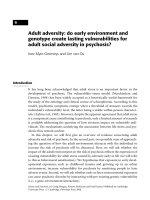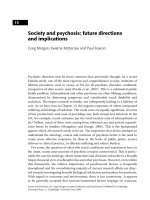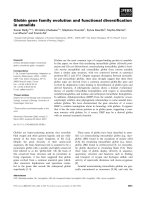Family environment and psychosis
Bạn đang xem bản rút gọn của tài liệu. Xem và tải ngay bản đầy đủ của tài liệu tại đây (107.15 KB, 15 trang )
8
Family environment and psychosis
Pekka Tienari and Karl-Erik Wahlberg
Introduction
As with all forms of illness and disability, the primary burden of care for those with
an enduring mental illness frequently falls on the family. Undoubtedly, without
the ongoing support provided by close family, the impact of schizophrenia and
other psychoses on the lives of many sufferers would be greatly increased. Families
can provide emotional and practical support, continuity of care, and much needed
help in negotiating interactions with professional mental health services. It is no
surprise, then, that suggestions that families cause schizophrenia, as some asserted
in the 1960s and 1970s (see Hirsch and Leff, 1975), were met with disbelief and
anger. Singer and Wynne (1965) stated in their paper concerning the family
relationships of patients with schizophrenia that biological and hereditary factors
do contribute to disturbed transactions in some families. The majority of pioneers
of family dynamic research did not, in fact, assert that parents were responsible for
the psychosis in their children. Instead, they thought that many parents themselves
were in need of help. However, many relatives felt that they were being blamed;
they felt hurt, alienated and negatively labelled (Hatfield et al., 1987).
It is important, therefore, that any discussion of families, the family environ-
ment and psychosis begin with three important disclaimers. First, as noted above,
families frequently provide invaluable support and shoulder a large burden of care.
Second, families (and specifically mothers) do not cause schizophrenia or any
other psychosis. Third, the overwhelming majority of families provide positive,
nurturing environments. However, this should not, and does not, lead to the
conclusion that family environment is irrelevant in understanding the onset and
course of psychosis. Hirsch and Leff (1975), in their early review, concluded that
there was a need for further research to test the more modest propositions that
difficult and problematic family environments may increase the risk of schizo-
phrenia and other psychoses, and worsen the course of these disorders.
Society and Psychosis, ed. Craig Morgan, Kwame McKenzie and Paul Fearon. Published by Cambridge
University Press. # Cambridge University Press 2008.
In this chapter, we aim to provide an overview of research relating to family
environment and schizophrenia and other psychoses. The most frequently studied
intrafamilial factors are family communication and ‘expressed emotion’ (EE), and
we will focus specifically on these in assessing the evidence for the role of family
environment in the aetiology and course of psychosis. Within the scope of this
chapter, it is not possible to discuss fully the methodological issues in the study of
family environment and psychosis. A thorough book is available on this topic
(Jacob, 1987).
History: early studies
Apart from the question of the aetiology of schizophrenia, early studies of the
families of patients with schizophrenia made two major contributions to our
understanding of family dynamics: first, their focus on the family group was an
important advance over traditional, individual-focused approaches; second,
through the development of specific concepts, such as ‘double bind’, ‘fragmenta-
tion’ and ‘pseudo-mutuality’, they alerted us to certain potentially important
phenomena in family life (Mishler and Waxler, 1965).
Goldstein and Strachan (1987) reviewed in detail the different aspects of earlier
family research in relation to schizophrenia. They concluded that the large
number of cross-sectional family studies has shown one consistent finding: the
parents of patients with schizophrenia tend to show a deficit in their ability to
share a focus of attention, to adopt the perspective of another person, and to
communicate meaning clearly and accurately. But only in the area of communi-
cation accuracy have cross-sectional comparison studies revealed consistent differ-
ences between families of patients with schizophrenia and other families. They
further concluded that disturbed communication and negative affect in families
precede the development of schizophrenia spectrum disorders. It is, however,
doubtful whether these findings are specific to schizophrenia. Further, their review
suggested that family factors affect the course of schizophrenia, and that there is
considerable continuity between the negative affective factors that precede the
onset of the disorder and those that are predictive of course and outcome. To
disentangle these issues further, they emphasised the value of high-risk longitudi-
nal designs.
After the initial enthusiasm in the 1950s and 1960s, research on family dynamics
declined, partly for the reasons outlined above. However, investigations on intra-
familial communication, EE and the efficacy of family interventions have been
actively continued. In addition, interest in the interplay of genetic and environ-
mental factors has been maintained. It is to this more recent research that we
now turn.
113 Family environment and psychosis
Familial communication in schizophrenia
Early research, as noted above, hinted at there being unclear and ambiguous
communication patterns in the families of patients with schizophrenia. Research
findings appear to confirm a greater prevalence of communication disturbance in
the parents of schizophrenic patients than in other parents (e.g., Docherty et al.,
1998; Goldstein, 1987a). There is further evidence that siblings of those with schizo-
phrenia have more communication problems than other children (Docherty et al.,
2004). These findings have been interpreted as suggesting that communication
disturbances are indicators of genetic vulnerability in parents (e.g., Subotnik et al.,
2002). However, this seems to be too simplified an explanation of the origin of
disturbed communication patterns.
The ‘communication deviance’ (CD) construct and scale were developed by
Wynne and Singer (Singer et al., 1978) to describe the disturbed communi-
cation styles found in the families of patients diagnosed with schizophrenia.
Communication deviance is a scale that measures the degree to which a person
does not share and maintain a focus of attention when communicating with other
persons (Singer and Wynne, 1966), and to which meanings are not consensually or
visibly validated. The scale consists of 42 categories adapted from the Singer–Wynne
Rorschach scoring manual (Singer and Wynne, 1966, unpublished 1986 version, by
M. T. Singer and L. C. Wynne). The most frequent and influential items of the CD
scale are ‘abandoned, abruptly ceased, uncorrected remarks’, ‘inability or failure to
verify own responses’, ‘odd sentence construction’ and ‘reiteration’. Communication
deviance has most often been measured from standardised, verbatim Rorschach test
records, and the essential issue is not the intrapsychic phenomena as traditionally
interpreted, but more the pattern of reciprocal shared perceptions, focusing on
attention and meaning in the communication process. In one study using this
construct, in a subsample of the Finnish Adoptive Family Study of Schizophrenia,
Wahlberg et al. (1997) found that adoptees at a high genetic risk, and with high-CD
adoptive parents, had more sub-syndromal thought disorder than low-risk adoptees
with high-CD adoptive parents. The high-risk adoptees with low-CD adoptive
parents had slightly lower levels of sub-syndromal thought disorder than the low-
risk adoptees of low-CD adoptive parents, findings which are suggestive of a gene–
environment interaction and sensitivity of the genetic high-risk adoptees to the
family environment (see below). Further, Wahlberg et al. (2004) provide more
evidence of gene–environment interaction in schizophrenia. They found that high-
risk adoptees with high-CD adoptive parents had more mental disorders than low-
risk adoptees with high-CD adoptive parents. Again, high-risk adoptees with low-CD
adoptive parents had the same incidence of mental disorders as low-risk adoptees
with low-CD adoptive parents. These findings support the biopsychosocial concept
114 P. Tienari and K.-E. Wahlberg
of an interaction between genetic vulnerability or sensitivity and risk factors in the
family rearing environment. The form of communication style considered here is
likely to hinder a child’s cognitive development (especially in logical thinking and
problem solving). These findings further suggest that more common communication
styles support the cognitive development of high-risk children, perhaps protecting
the vulnerable from schizophrenia. These results suggest that schizophrenia has both
a genetic and an environmental base, and that neither alone can fully account for the
illness.
Origins of communication deviance
It has been proposed that some children, exhibiting strange and incomprehensible
behaviour indicative of an increased genetic risk for schizophrenia, evoke in their
parents more negative and inconsistent ways of communicating (Bell, 1968). This
may well be true in some cases, but it is questionable whether a child’s behaviour
can evoke such changes in parents in the long term. For example, levels of CD have
been found to be stable during adulthood over an 11 year time span (Wahlberg
et al., 2001). Communication deviance also remains stable when a person is tested
either alone or with his or her spouse and child (Keskitalo, 2000). Wahlberg et al.
(1997) have further found that levels of CD in parents of adoptees at high genetic
risk are similar to those of parents of adoptees at low genetic risk. This suggests that
behavioural manifestations of genetic vulnerability for schizophrenia in adopted
children do not provoke communication disturbances in parents. In the Wahlberg
et al. (2004) study, all adoptees were mentally healthy at the time the CD of the
adoptive parents was measured. The presence of mental disorder in the adoptees
was measured 11 years later. Putting these findings together, we can assume that
CD is a stable trait and not simply a reflective product of a disturbed child.
The stability of CD indicates that high parental CD scores contribute to an
enduring atmosphere in the family, which may shape cognitive function, especially
the thought processes of a developing child.
Expressed emotion
Expressed emotion is a measure of family environment that is based on how the
parents or other carers talk about their ill relative. Based on the Camberwell Family
Interview (CFI) (Vaughn and Leff, 1976), a long and detailed tape-recorded semi-
structured interview, parents or other carers are classified as being high in EE if they
make more than a specified number of critical comments or show any signs of
hostility or marked emotional over-involvement. Positive aspects of the relationship
may also be measured in the form of positive comments – a frequency count – and
115 Family environment and psychosis
warmth, a scaled score taking into account attitudes and comments evidenced
throughout the interview. However, it is the dimensions of criticism, hostility and
emotional over-involvement that are used to determine high and low levels of EE
(Barrowclough and Hooley, 2003). In some studies, scoring has been based on a five-
minute speech sample (Magana, 1990; Marom et al., 2005). Kavanagh et al. (1997)
have developed a 30-item self-completed questionnaire for relatives, called the Family
Attitude Scale. However, the CFI remains the gold standard.
Expressed emotion has been found to be a reliable psychosocial predictor of
relapse in schizophrenia (e.g., Butzlaff and Hooley, 1998). Marom et al. (2005)
demonstrated the prolonged (up to seven years) predictive validity of EE in respect
to psychiatric hospitalisation. There is also a growing literature concerning the role
of EE in unipolar depression, bipolar disorder and eating disorders. Indeed, rather
than being a construct of interest solely with respect to schizophrenia, EE is a more
general predictor of poor outcome across a range of conditions. Furthermore, EE
is a construct that is modifiable (Butzlaff and Hooley, 1998). In the University of
California at Los Angeles (UCLA) High Risk Project (Goldstein, 1987b), EE
preceded and predicted the development of schizophrenia spectrum disorders
(communication deviance and affective style were even stronger predictors). It
seems that EE may have some role in the aetiology of psychosis, even though its
ability to predict relapse has been more strongly confirmed.
Evidence is accumulating to show that high-EE and low-EE relatives may differ in
the beliefs they hold about the patient and the problem behaviours associated with
the patient’s illness. In particular, several studies have shown that critical relatives are
more likely to hold patients responsible for their difficulties (Barrowclough and
Hooley, 2003). Compared with low-EE relatives, high-EE relatives appear more
conventional in their behaviour (higher norm favouring) and less satisfied with
themselves and their lives (lower self-realisation). High-EE relatives may also be less
flexible and tolerant and rate lower on empathy and achievement through independ-
ence than low-EE relatives. In a study by Hooley and Hiller (2000), even after
potential demographic confounders were controlled, inflexibility remained a signi-
ficant predictor of high-EE. Heikkila
¨
et al. (2006), in a study of consecutive first-
episode patients from a defined geographic area, found evidence that good cognitive
functioning in patients may be associated with higher EE scores in relatives, a finding
that may reflect the higher expectations (and consequent disappointments) of rela-
tives of intellectually more able children. In another study, Patterson et al. (2005)
found that a high-EE relationship involving high emotional over-involvement and
critical comments may have adaptive functions, for example, in enabling the relative
to respond to the crisis of a family member developing a psychosis.
Kuipers et al. (2006) found that patients whose carers showed high EE had
significantly higher levels of anxiety and depression, but not more psychotic
116 P. Tienari and K.-E. Wahlberg
symptoms or lower self-esteem. Thus, their research hypothesis suggesting that the
effect of high EE is mediated through affective changes in patients was partially
supported. Even at the time of the first episode, the carers’ psychological appraisal,
rather than the patient’s illness, appears to be influential in determining high EE
(Raune et al., 2004).
Family interventions
Studies of the efficacy of family interventions for those with psychosis provide
further relevant evidence. The Schizophrenia Patient Outcome Research Team,
funded by the US National Institute of Mental Health (NIMH) (Lehman et al.,
1998), suggested that individual and group psychotherapies adhering to a psycho-
dynamic model and family therapies based on the premise that family dysfunction is
of primary importance in the aetiology of the schizophrenia should be avoided.
Psychotherapists and family therapists did not accept this view. Many felt that
the recommendations were not based on a full exploration of the field of psycho-
logical therapies (Silver and Larsen, 2003). They have since been modified. The
Schizophrenia Patient Outcome Research Team, in their updated treatment recom-
mendations, stated that: ‘Persons with schizophrenia and their families who have
ongoing contact with each other should be offered a family intervention, the key
elements of which include a duration of at least nine months, illness education, crisis
intervention, emotional support, and training in how to cope with illness symptoms
and related problems.’ (Lehman et al., 2004, p. 202.)
Pitschel-Walz et al. (2001) and Pilling et al. (2002) have both published meta-
analyses of family intervention studies. Both included randomised controlled trials
only. Pilling and colleagues, basing their review on ‘intention to treat’ analyses,
found that family intervention reduced relapse rates and re-hospitalisations, and
improved compliance with medication.
Alanen (2004) has described the implementation of family interventions for
patients with schizophrenia in Finland. Correspondingly, family interventions in
bipolar disorders have been described in detail by Miklowitz and Goldstein (1997)
and Callahan and Bauer (1999). The cause-and-effect relationships between mood
disorder symptoms and family environmental factors are bidirectional; families
are affected by the bipolar disorder as much as they affect it. There is no convincing
evidence that disturbed family relationships cause the onset of bipolar disorder. In
the absence of longitudinal high risk research, it is not possible to establish, with
any certainty, causal connections between features of the childhood family envi-
ronment and the eventual onset of bipolar disorder (or schizophrenia or other
psychoses) in adulthood. Stierlin et al. (1986) reported their observations from a
study of families, each with a young adult member who had been diagnosed as
117 Family environment and psychosis









